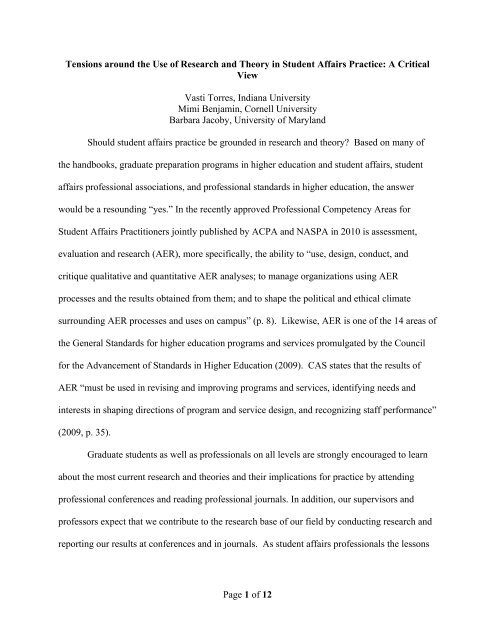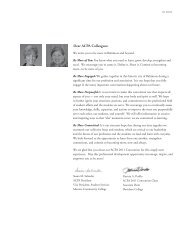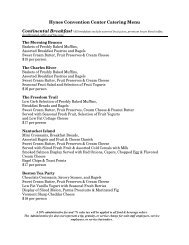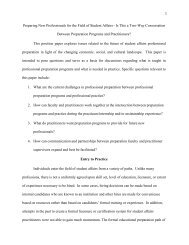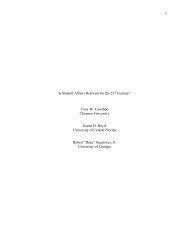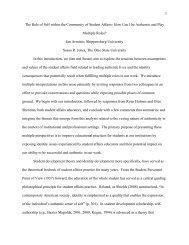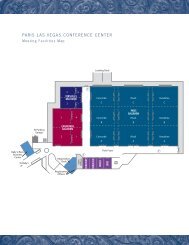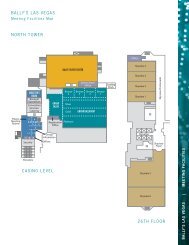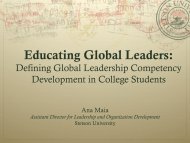Tensions around the Use of Research and Theory in Student Affairs ...
Tensions around the Use of Research and Theory in Student Affairs ...
Tensions around the Use of Research and Theory in Student Affairs ...
You also want an ePaper? Increase the reach of your titles
YUMPU automatically turns print PDFs into web optimized ePapers that Google loves.
<strong>Tensions</strong> <strong>around</strong> <strong>the</strong> <strong>Use</strong> <strong>of</strong> <strong>Research</strong> <strong>and</strong> <strong>Theory</strong> <strong>in</strong> <strong>Student</strong> <strong>Affairs</strong> Practice: A Critical<br />
View<br />
Vasti Torres, Indiana University<br />
Mimi Benjam<strong>in</strong>, Cornell University<br />
Barbara Jacoby, University <strong>of</strong> Maryl<strong>and</strong><br />
Should student affairs practice be grounded <strong>in</strong> research <strong>and</strong> <strong>the</strong>ory? Based on many <strong>of</strong><br />
<strong>the</strong> h<strong>and</strong>books, graduate preparation programs <strong>in</strong> higher education <strong>and</strong> student affairs, student<br />
affairs pr<strong>of</strong>essional associations, <strong>and</strong> pr<strong>of</strong>essional st<strong>and</strong>ards <strong>in</strong> higher education, <strong>the</strong> answer<br />
would be a resound<strong>in</strong>g “yes.” In <strong>the</strong> recently approved Pr<strong>of</strong>essional Competency Areas for<br />
<strong>Student</strong> <strong>Affairs</strong> Practitioners jo<strong>in</strong>tly published by ACPA <strong>and</strong> NASPA <strong>in</strong> 2010 is assessment,<br />
evaluation <strong>and</strong> research (AER), more specifically, <strong>the</strong> ability to “use, design, conduct, <strong>and</strong><br />
critique qualitative <strong>and</strong> quantitative AER analyses; to manage organizations us<strong>in</strong>g AER<br />
processes <strong>and</strong> <strong>the</strong> results obta<strong>in</strong>ed from <strong>the</strong>m; <strong>and</strong> to shape <strong>the</strong> political <strong>and</strong> ethical climate<br />
surround<strong>in</strong>g AER processes <strong>and</strong> uses on campus” (p. 8). Likewise, AER is one <strong>of</strong> <strong>the</strong> 14 areas <strong>of</strong><br />
<strong>the</strong> General St<strong>and</strong>ards for higher education programs <strong>and</strong> services promulgated by <strong>the</strong> Council<br />
for <strong>the</strong> Advancement <strong>of</strong> St<strong>and</strong>ards <strong>in</strong> Higher Education (2009). CAS states that <strong>the</strong> results <strong>of</strong><br />
AER “must be used <strong>in</strong> revis<strong>in</strong>g <strong>and</strong> improv<strong>in</strong>g programs <strong>and</strong> services, identify<strong>in</strong>g needs <strong>and</strong><br />
<strong>in</strong>terests <strong>in</strong> shap<strong>in</strong>g directions <strong>of</strong> program <strong>and</strong> service design, <strong>and</strong> recogniz<strong>in</strong>g staff performance”<br />
(2009, p. 35).<br />
Graduate students as well as pr<strong>of</strong>essionals on all levels are strongly encouraged to learn<br />
about <strong>the</strong> most current research <strong>and</strong> <strong>the</strong>ories <strong>and</strong> <strong>the</strong>ir implications for practice by attend<strong>in</strong>g<br />
pr<strong>of</strong>essional conferences <strong>and</strong> read<strong>in</strong>g pr<strong>of</strong>essional journals. In addition, our supervisors <strong>and</strong><br />
pr<strong>of</strong>essors expect that we contribute to <strong>the</strong> research base <strong>of</strong> our field by conduct<strong>in</strong>g research <strong>and</strong><br />
report<strong>in</strong>g our results at conferences <strong>and</strong> <strong>in</strong> journals. As student affairs pr<strong>of</strong>essionals <strong>the</strong> lessons<br />
Page 1 <strong>of</strong> 12
are taught early on that we should be practitioner-scholars or scholar-practitioners by ground<strong>in</strong>g<br />
our work <strong>in</strong> research regard<strong>in</strong>g student characteristics, needs, <strong>and</strong> experiences.<br />
As a result, most student affairs pr<strong>of</strong>essionals believe that research-based practice is<br />
appropriate <strong>and</strong> desired <strong>in</strong> practice, yet little is asked about what research results should be<br />
applied <strong>and</strong> which ones should be questioned. This question<strong>in</strong>g <strong>of</strong> how research should be<br />
applied must come from both faculty researchers <strong>and</strong> practitioners. If one looks a little deeper<br />
<strong>and</strong> more critically, tensions arise that <strong>the</strong> field <strong>of</strong> student affairs may not have anticipated.<br />
This essay seeks to explore <strong>the</strong> tensions that can arise by look<strong>in</strong>g at <strong>the</strong> process <strong>of</strong><br />
apply<strong>in</strong>g research <strong>in</strong> practice <strong>and</strong> <strong>the</strong> next steps that should be considered <strong>in</strong> creat<strong>in</strong>g practice<br />
that is <strong>in</strong>formed by what we know about students. As one <strong>of</strong> <strong>the</strong> Senior Scholar essays, <strong>the</strong> goal<br />
<strong>of</strong> this essay is to promote critical reflection on current practices <strong>and</strong> <strong>the</strong> future <strong>of</strong> <strong>the</strong> field.<br />
<strong>Tensions</strong> <strong>around</strong> <strong>Research</strong> <strong>and</strong> Practice<br />
In spite <strong>of</strong> <strong>the</strong> clarity <strong>of</strong> <strong>the</strong> call for research-based practice, <strong>the</strong> actual implementation <strong>of</strong><br />
this process is less clear. This section attempts to consider <strong>the</strong> actual implementation <strong>of</strong> research<br />
<strong>in</strong>to <strong>the</strong> practice <strong>of</strong> student affairs. To do this, we beg<strong>in</strong> with trends that occur <strong>in</strong> practice, <strong>the</strong>n<br />
move <strong>in</strong>to ethical <strong>and</strong> philosophical considerations <strong>around</strong> <strong>the</strong> application <strong>of</strong> research, <strong>and</strong> end<br />
with <strong>the</strong> trends common to researchers.<br />
Trends <strong>of</strong> Concern <strong>in</strong> Practice<br />
As mentioned earlier, creat<strong>in</strong>g research-based practices <strong>and</strong> policies is generally seen as a<br />
desirable approach, as evidenced <strong>in</strong> both <strong>the</strong> CAS St<strong>and</strong>ards (2009) <strong>and</strong> <strong>the</strong> new Pr<strong>of</strong>essional<br />
Competencies for <strong>Student</strong> <strong>Affairs</strong> Practitioners (2011). New terms have emerged with<strong>in</strong> student<br />
affairs nomenclature to designate <strong>the</strong> scholar-practitioner or practitioner-scholar; <strong>the</strong> order <strong>of</strong> <strong>the</strong><br />
terms would designate <strong>the</strong> primary duties first, with <strong>the</strong> second <strong>in</strong>dicat<strong>in</strong>g <strong>the</strong> importance <strong>of</strong> how<br />
Page 2 <strong>of</strong> 12
esearch is applied. While <strong>the</strong> scholar-practitioner has some clear expectations <strong>around</strong> mak<strong>in</strong>g<br />
sure that research applies to practice, <strong>the</strong> characteristics <strong>of</strong> <strong>the</strong> practitioner-scholar <strong>and</strong> how<br />
research is actually applied is an elusive concept.<br />
Consider<strong>in</strong>g that Bliml<strong>in</strong>g (2011) posits that personal experiences guide reflective or<br />
experienced practitioners between 60% to 80% <strong>of</strong> <strong>the</strong> time, one must consider just what trends<br />
<strong>in</strong>fluence practice. In practice <strong>the</strong>re seem to several common approaches that promote<br />
questionable trends. While <strong>the</strong>re are consistent efforts to “pr<strong>of</strong>essionalize” student affairs, <strong>in</strong><br />
part by mak<strong>in</strong>g <strong>the</strong> supposition that practice is based on research, several questionable trends<br />
illustrate that <strong>the</strong>re is much room for improvement <strong>and</strong> that <strong>the</strong> outcomes <strong>of</strong> <strong>the</strong>se trends may not<br />
benefit students.<br />
• The use <strong>of</strong> personal experience to determ<strong>in</strong>e effective practices for today’s students<br />
rema<strong>in</strong>s a troubl<strong>in</strong>g issue. For example, this may occurs when practitioners with fond<br />
memories <strong>of</strong> orientation week <strong>and</strong> <strong>the</strong>refore believe that every student will need, enjoy<br />
<strong>and</strong> be enriched <strong>in</strong> <strong>the</strong> same way <strong>the</strong>y were. Yet, this approach denies <strong>the</strong> demographic<br />
diversity that has emerged <strong>in</strong> higher education over <strong>the</strong> past years <strong>and</strong> asserts that all<br />
students are <strong>the</strong> same; which is completely contrary to <strong>the</strong> philosophy <strong>of</strong> <strong>the</strong> <strong>Student</strong><br />
Personnel Po<strong>in</strong>t <strong>of</strong> View (SPPV) (1939). For example, <strong>the</strong> length <strong>of</strong> orientation seems to<br />
be completely different between community colleges <strong>and</strong> residential 4-year <strong>in</strong>stitutions.<br />
How do we know one is actually better than <strong>the</strong> o<strong>the</strong>r? Often personal experience or<br />
mis<strong>in</strong>terpretation <strong>of</strong> research is used to justify a practitioner’s preference; this leads to <strong>the</strong><br />
next common practice.<br />
• A second common practice is <strong>the</strong> overgeneralization <strong>of</strong> research f<strong>in</strong>d<strong>in</strong>gs <strong>and</strong> apply<strong>in</strong>g<br />
developmental <strong>the</strong>ories equally to all students. Similar to <strong>the</strong> first concern, this implies<br />
Page 3 <strong>of</strong> 12
that all students are <strong>the</strong> same. This <strong>of</strong>ten happens <strong>in</strong> <strong>the</strong> application <strong>of</strong> developmental<br />
<strong>the</strong>ories to programmatic <strong>of</strong>fer<strong>in</strong>gs; like us<strong>in</strong>g Chicker<strong>in</strong>g’s Vectors (Chicker<strong>in</strong>g, 1969;<br />
Chicker<strong>in</strong>g & Reisser, 1993) to frame all programm<strong>in</strong>g <strong>in</strong> <strong>the</strong> residence halls. While<br />
many students f<strong>in</strong>d <strong>the</strong> Vectors mean<strong>in</strong>gful to <strong>the</strong>ir lives, many students outside <strong>the</strong><br />
middle-class, m<strong>in</strong>ority populations, <strong>and</strong>/or students from non-traditional families may<br />
struggle to see how programs framed <strong>around</strong> <strong>the</strong> Vectors apply to <strong>the</strong>ir lived experiences.<br />
An adult child <strong>of</strong> an alcoholic is likely to experience autonomy very differently than <strong>the</strong><br />
traditional students everyone th<strong>in</strong>ks represents every student. Though <strong>the</strong>ories are<br />
updated <strong>and</strong> revised, seldom do <strong>the</strong>y become universally applicable to all students.<br />
Underst<strong>and</strong><strong>in</strong>g <strong>the</strong> applicability <strong>of</strong> <strong>the</strong>ories leads to <strong>the</strong> third common practice<br />
• A third unfortunate yet common practice is apply<strong>in</strong>g a research f<strong>in</strong>d<strong>in</strong>g <strong>in</strong> practice<br />
without question<strong>in</strong>g <strong>the</strong> validity, value, or limitations <strong>of</strong> <strong>the</strong> research (e.g. sample or<br />
context with<strong>in</strong> <strong>the</strong> study). Not all research is good research <strong>and</strong> research f<strong>in</strong>d<strong>in</strong>gs are not<br />
universally applicable. Aga<strong>in</strong>, this approach assumes all students are <strong>the</strong> same <strong>and</strong> adds<br />
that all higher education environments are also <strong>the</strong> same. It can be difficult to know if this<br />
occurs because <strong>of</strong> a belief that all research is <strong>in</strong>herently trustworthy or if <strong>in</strong>dividuals lack<br />
<strong>the</strong> skills to question <strong>the</strong> study – perhaps it is both <strong>of</strong> <strong>the</strong>se issues. Examples <strong>of</strong> this are<br />
most <strong>of</strong>ten found <strong>in</strong> <strong>the</strong> use <strong>of</strong> retention models. Despite hav<strong>in</strong>g models that look at<br />
commuter students, students <strong>of</strong> color, as well as o<strong>the</strong>r student populations, many<br />
<strong>in</strong>stitutions assume us<strong>in</strong>g only <strong>the</strong> T<strong>in</strong>to (1983) model <strong>of</strong> <strong>in</strong>tegration will garner a higher<br />
retention rate. Question<strong>in</strong>g whe<strong>the</strong>r <strong>the</strong> <strong>in</strong>stitution <strong>and</strong> students have similar<br />
characteristics or environmental conditions to those found with<strong>in</strong> <strong>the</strong> sample for <strong>the</strong><br />
Page 4 <strong>of</strong> 12
orig<strong>in</strong>al study is seldom a part <strong>of</strong> <strong>the</strong> discussion with<strong>in</strong> a retention committee, much less<br />
<strong>the</strong> external consultant.<br />
All <strong>the</strong>se approaches have <strong>in</strong> common a series <strong>of</strong> ethical <strong>and</strong> philosophical considerations that<br />
should be considered when work<strong>in</strong>g with students <strong>and</strong> us<strong>in</strong>g research to guide your work.<br />
Philosophical <strong>and</strong> Ethical Considerations<br />
S<strong>in</strong>ce <strong>the</strong> <strong>in</strong>ception <strong>of</strong> <strong>the</strong> field <strong>of</strong> student affairs, <strong>the</strong> belief that each student is unique<br />
<strong>and</strong> that <strong>the</strong> field should consider <strong>the</strong> student as a whole has been at <strong>the</strong> forefront <strong>of</strong> <strong>the</strong><br />
foundational beliefs (SPPV). When <strong>the</strong>se beliefs were articulated, higher education was fairly<br />
homogeneous <strong>and</strong> perhaps assum<strong>in</strong>g some commonalities was natural. This is <strong>the</strong> not <strong>the</strong> case<br />
today. The diversity <strong>of</strong> higher education <strong>and</strong> <strong>the</strong> diversity with<strong>in</strong> <strong>the</strong> field <strong>of</strong> student affairs<br />
require practitioners to question almost any common practice. Some <strong>of</strong> <strong>the</strong>se examples were<br />
illustrated previously <strong>in</strong> <strong>the</strong> common trends. This section seeks to consider when perhaps<br />
research should not be applied.<br />
There are times when a research f<strong>in</strong>d<strong>in</strong>g is compell<strong>in</strong>g, yet <strong>the</strong> application <strong>of</strong> <strong>the</strong> f<strong>in</strong>d<strong>in</strong>g<br />
would exclude some students from higher education. An example <strong>of</strong> this is <strong>around</strong> <strong>the</strong> need for<br />
developmental, or remedial, education. While <strong>the</strong>re is evidence that a student who is <strong>in</strong> <strong>the</strong><br />
marg<strong>in</strong>s <strong>of</strong> be<strong>in</strong>g college ready (placement score) will receive some benefit from be<strong>in</strong>g assigned<br />
to a remedial course, <strong>the</strong> research seems to say that <strong>the</strong>ir long-term process towards earn<strong>in</strong>g a<br />
degree is not helped by remediation (Calcagno & Long, 2008). Even though this study uses very<br />
sophisticated analysis, it does not actually provide much long-term hope for students <strong>in</strong> remedial<br />
education. The authors recommend reconsider<strong>in</strong>g <strong>the</strong> fund<strong>in</strong>g <strong>of</strong> remedial education given <strong>the</strong><br />
limited outcomes. For community colleges practitioners who have open access admissions <strong>and</strong><br />
attract students who need remediation – what should <strong>the</strong>y do with this research f<strong>in</strong>d<strong>in</strong>g? The<br />
Page 5 <strong>of</strong> 12
sophistication <strong>of</strong> this study may <strong>in</strong>form policy leaders, yet consideration should be given to how<br />
research would <strong>in</strong>fluence <strong>the</strong> practitioners who work with students on a daily basis. This<br />
requires that <strong>the</strong> trends among researchers also be considered <strong>in</strong> this critical exam<strong>in</strong>ation.<br />
Trends <strong>of</strong> Concern <strong>in</strong> <strong>Research</strong><br />
In spite <strong>of</strong> several attempts to guide <strong>the</strong> type <strong>of</strong> research conducted with<strong>in</strong> student affairs<br />
(e.g. Future Trends <strong>in</strong> <strong>Student</strong> <strong>Affairs</strong>, NASPA Faculty Fellows <strong>Research</strong> Agenda for <strong>the</strong><br />
Pr<strong>of</strong>ession), most researchers <strong>in</strong>vestigate topics that <strong>in</strong>terest <strong>the</strong>m ra<strong>the</strong>r than what might be<br />
needed with<strong>in</strong> <strong>the</strong> field. The trends <strong>of</strong> concern for researchers highlighted below are tensions<br />
that perhaps may not be resolved. What an <strong>in</strong>stitution values as “research” plays a role <strong>in</strong> how<br />
<strong>the</strong>se concerns get highlighted.<br />
• The pressure for faculty to obta<strong>in</strong> external fund<strong>in</strong>g is also <strong>in</strong>fluenc<strong>in</strong>g <strong>the</strong> type <strong>of</strong> research<br />
that is conducted with<strong>in</strong> <strong>the</strong> field. Fund<strong>in</strong>g agencies are sett<strong>in</strong>g <strong>the</strong> research agenda for<br />
higher education <strong>and</strong> mak<strong>in</strong>g it difficult to secure funds to carry out projects that may be<br />
more focused on practice.<br />
• <strong>Research</strong> topics generated by practitioners are <strong>of</strong>ten issues with no clear answers <strong>and</strong> are<br />
thus not necessarily issues that need more research. For example, <strong>the</strong>re is a tremendous<br />
amount <strong>of</strong> research on student alcohol abuse, yet practitioners frequently say more<br />
research is required. The tension with this trend is that practitioners want a direct<br />
practical answer to problems, <strong>and</strong> researchers know those seldom exist. This tension<br />
requires more explicit explanation <strong>of</strong> <strong>the</strong> application <strong>of</strong> research.<br />
• The values <strong>of</strong> <strong>the</strong> academic arena are not always consistent with <strong>the</strong> desires <strong>of</strong><br />
practitioners. While practice-oriented scholarship may be highly desired by student<br />
affairs practitioners, <strong>the</strong> faculty promotion <strong>and</strong> tenure portfolios are evaluated by <strong>the</strong><br />
Page 6 <strong>of</strong> 12
igor <strong>of</strong> <strong>the</strong> research ra<strong>the</strong>r than its applicability to practice. Graduate preparation faculty<br />
at research universities are <strong>of</strong>ten asked to expla<strong>in</strong> why <strong>the</strong>ir research should be focused<br />
towards application. The conflict between <strong>the</strong>ir academic <strong>and</strong> student affairs foci arise on<br />
a regular basis.<br />
• While an evaluation <strong>of</strong> programs is highly desirable for a practitioner, it is not seen as<br />
research among <strong>the</strong> faculty. Faculty members dist<strong>in</strong>guish between research, assessment,<br />
<strong>and</strong> evaluation. Some practitioners assume <strong>the</strong>y are <strong>the</strong> same.<br />
Recogniz<strong>in</strong>g <strong>the</strong> tensions between research <strong>and</strong> application <strong>in</strong> student affairs is a start<strong>in</strong>g po<strong>in</strong>t.<br />
To address <strong>the</strong>se tensions requires a concerted effort <strong>and</strong> several steps.<br />
Next Steps for Address<strong>in</strong>g <strong>the</strong> <strong>Tensions</strong> <strong>around</strong> Us<strong>in</strong>g <strong>Research</strong> <strong>in</strong> <strong>Student</strong>s <strong>Affairs</strong><br />
Practice<br />
Consider<strong>in</strong>g <strong>the</strong> fact that we <strong>of</strong>ten differentiate between a “practitioner,” “scholar,” <strong>and</strong><br />
“practitioner-scholar/scholar-practitioner” with <strong>the</strong> majority <strong>of</strong> adm<strong>in</strong>istrators categorized as<br />
“practitioners,” we have semantically positioned our pr<strong>of</strong>ession as those who create/use<br />
<strong>the</strong>ory/research <strong>and</strong> those who do not. Practitioners represent a range <strong>of</strong> consumer<br />
characteristics about research: reject research, critical consumers, or pacifist consumers.<br />
Regardless <strong>of</strong> <strong>the</strong> where on <strong>the</strong> range one falls <strong>the</strong>se choices require devot<strong>in</strong>g time to <strong>the</strong> practice<br />
<strong>of</strong> student affairs <strong>and</strong> not f<strong>in</strong>d<strong>in</strong>g/mak<strong>in</strong>g time to stay current on <strong>the</strong> research that could/should<br />
<strong>in</strong>form <strong>the</strong>ir practice. Those who tend to be most familiar with current <strong>the</strong>ory <strong>and</strong> research may<br />
be our recent graduates; some upper-level adm<strong>in</strong>istrators also may ma<strong>in</strong>ta<strong>in</strong> a current knowledge<br />
base <strong>in</strong> order to expla<strong>in</strong> <strong>and</strong> justify student affairs work with<strong>in</strong> <strong>the</strong> greater context <strong>of</strong> a college or<br />
university (<strong>and</strong> garner <strong>the</strong> necessary resources). In many cases, it is probable that <strong>the</strong> longer<br />
pr<strong>of</strong>essionals are out <strong>of</strong> graduate school <strong>the</strong> less likely <strong>the</strong>y will be able to keep up-to-date with<br />
<strong>the</strong> latest research <strong>and</strong> <strong>the</strong>ory. Despite <strong>the</strong> importance <strong>of</strong> cont<strong>in</strong>u<strong>in</strong>g to read pr<strong>of</strong>essional<br />
Page 7 <strong>of</strong> 12
publications, s<strong>in</strong>ce new <strong>in</strong>formation emerges <strong>and</strong> new approaches presented can be applied to<br />
adm<strong>in</strong>istrative work, more is be<strong>in</strong>g asked <strong>of</strong> <strong>in</strong>dividuals <strong>in</strong> <strong>the</strong>se economic times <strong>and</strong> less time is<br />
available for activities like pr<strong>of</strong>essional read<strong>in</strong>g.<br />
“Pr<strong>of</strong>essional judgment,” accord<strong>in</strong>g to Bliml<strong>in</strong>g (2011), is what results from <strong>the</strong><br />
comb<strong>in</strong>ation <strong>of</strong> experience <strong>and</strong> <strong>the</strong>ory to <strong>in</strong>form pr<strong>of</strong>essional practice. “[Pr<strong>of</strong>essional judgment]<br />
evolves from us<strong>in</strong>g experience <strong>in</strong> apply<strong>in</strong>g <strong>the</strong>ory to ref<strong>in</strong>e one’s way <strong>of</strong> th<strong>in</strong>k<strong>in</strong>g about practice”<br />
(Bliml<strong>in</strong>g, 45). Bliml<strong>in</strong>g constructed a matrix outl<strong>in</strong><strong>in</strong>g four styles <strong>of</strong> <strong>in</strong>tegrat<strong>in</strong>g <strong>the</strong>ory <strong>and</strong><br />
practice, which <strong>in</strong>cludes <strong>the</strong> Reflective-Practitioner, <strong>the</strong> Experienced-Practitioner, <strong>the</strong> Scholar-<br />
<strong>Research</strong>er, <strong>and</strong> <strong>the</strong> Scholar-Practitioner (46-7). Each uses <strong>the</strong>ory <strong>and</strong> experience to different<br />
degrees (Bliml<strong>in</strong>g notes that <strong>the</strong>se percentages highlight relative weights <strong>and</strong> are not absolutes),<br />
with <strong>the</strong> Reflective-Practitioner guided 60% by experience <strong>and</strong> 40% by <strong>the</strong>ory, <strong>the</strong> Experienced-<br />
Practitioner guided 80% by experience <strong>and</strong> 20% by <strong>the</strong>ory, <strong>the</strong> Scholar-<strong>Research</strong>er at 80%<br />
<strong>the</strong>ory <strong>and</strong> 20% experience, <strong>and</strong> <strong>the</strong> Scholar-Practitioner at 60% <strong>the</strong>ory <strong>and</strong> 40% experience. He<br />
states, “They [<strong>the</strong> styles noted] suggest that <strong>the</strong> use <strong>of</strong> <strong>the</strong>ory is not all or noth<strong>in</strong>g, <strong>and</strong> that <strong>the</strong><br />
nomenclature <strong>of</strong> scholar <strong>and</strong> practitioner only serves to def<strong>in</strong>e <strong>the</strong> tilt <strong>in</strong> <strong>the</strong> balance between<br />
us<strong>in</strong>g <strong>the</strong>ory or experience <strong>in</strong> mak<strong>in</strong>g pr<strong>of</strong>essional judgments” (47).<br />
For some, <strong>the</strong> use <strong>of</strong> <strong>the</strong>ory <strong>and</strong> research <strong>in</strong> <strong>the</strong>ir practice is so <strong>in</strong>ternalized that <strong>the</strong>y don’t<br />
realize <strong>the</strong>y’re us<strong>in</strong>g it: “Us<strong>in</strong>g <strong>the</strong>ory, research <strong>and</strong> assessment results <strong>in</strong> everyday practice<br />
assumes knowledge <strong>of</strong> each. For some student affairs adm<strong>in</strong>istrators, <strong>the</strong>ory, research on<br />
students <strong>and</strong> <strong>the</strong>ir learn<strong>in</strong>g, <strong>and</strong> assessment results are so <strong>in</strong>ternalized <strong>the</strong>y may not recognize<br />
when <strong>the</strong>y are putt<strong>in</strong>g <strong>the</strong>m to use” (Desler, 298). O<strong>the</strong>rs, however, may have had limited<br />
exposure to <strong>the</strong> <strong>in</strong>formation (perhaps primarily through graduate education) <strong>and</strong> <strong>the</strong>n found <strong>the</strong>ir<br />
adm<strong>in</strong>istrative roles so full that hav<strong>in</strong>g <strong>the</strong> opportunity to cont<strong>in</strong>ue read<strong>in</strong>g <strong>the</strong>ory, research <strong>and</strong><br />
Page 8 <strong>of</strong> 12
assessment results may have fallen <strong>of</strong>f <strong>the</strong> to-do list. When downsiz<strong>in</strong>g occurs, as has happened<br />
recently at many <strong>in</strong>stitutions, adm<strong>in</strong>istrators <strong>of</strong>ten have to cut someth<strong>in</strong>g out <strong>of</strong> <strong>the</strong>ir schedules,<br />
<strong>and</strong> read<strong>in</strong>g <strong>the</strong> pr<strong>of</strong>essional literature is easy to cut when o<strong>the</strong>r dem<strong>and</strong>s appear more press<strong>in</strong>g.<br />
Upcraft (1994) shared an anecdote regard<strong>in</strong>g an <strong>in</strong>teraction between himself <strong>and</strong> an<br />
adm<strong>in</strong>istrative colleague. When Upcraft asked his colleague if he had read a recent book, <strong>the</strong><br />
colleague said he did not have time to read <strong>and</strong> asked Upcraft to tell him about <strong>the</strong> book. This<br />
approach <strong>of</strong> hav<strong>in</strong>g someone else summarize does not engage critical thought about what is<br />
be<strong>in</strong>g written, but it may be <strong>the</strong> reality <strong>of</strong> some practitioners <strong>in</strong> higher education today.<br />
Is There a Simple Answer to These <strong>Tensions</strong>?<br />
As a way to create a culture where pr<strong>of</strong>essionals consume research, some have advocated<br />
for a registry or cont<strong>in</strong>u<strong>in</strong>g education credits to re<strong>in</strong>force <strong>the</strong> need to stay current <strong>in</strong> one’s<br />
pr<strong>of</strong>essional field, while o<strong>the</strong>rs have opposed this <strong>in</strong>itiative. The fact rema<strong>in</strong>s that <strong>in</strong>formed<br />
practice is a necessity, <strong>and</strong> us<strong>in</strong>g <strong>the</strong> common practice <strong>of</strong> rely<strong>in</strong>g on knowledge from one’s<br />
graduate experience (whe<strong>the</strong>r that occurred a few or many years ago) is not an acceptable<br />
pr<strong>of</strong>essional approach.<br />
As Stage <strong>and</strong> Dannells (2000) <strong>in</strong>dicated <strong>in</strong> <strong>the</strong>ir case study book focused on l<strong>in</strong>k<strong>in</strong>g<br />
<strong>the</strong>ory to practice, “The job <strong>of</strong> <strong>the</strong> <strong>the</strong>ory builder <strong>and</strong> some k<strong>in</strong>ds <strong>of</strong> researchers . . . is to ignore<br />
<strong>the</strong> f<strong>in</strong>er details <strong>of</strong> students’ lives. However, <strong>the</strong> student affairs pr<strong>of</strong>essional’s job is not to<br />
ignore <strong>the</strong>se details. This discrepancy is a major cause <strong>of</strong> <strong>the</strong> gap between researchers <strong>and</strong><br />
<strong>the</strong>orists <strong>and</strong> <strong>the</strong> practitioners” (pp. 6-7). It is this tension between <strong>the</strong> roles <strong>of</strong> researcher <strong>and</strong><br />
practitioner that is accepted ra<strong>the</strong>r than questioned. Upcraft (1993) <strong>in</strong>dicated that <strong>the</strong>oretical<br />
scholars may be so distanced from <strong>the</strong> day-to-day work <strong>of</strong> adm<strong>in</strong>istrators that <strong>the</strong>ir <strong>the</strong>ories have<br />
little relevance to campus issues <strong>and</strong> practitioners (438). That may have been <strong>the</strong> case <strong>in</strong> <strong>the</strong><br />
Page 9 <strong>of</strong> 12
1960s <strong>and</strong> 1970s; today many faculty members worked as practitioners <strong>and</strong> <strong>the</strong>ir research<br />
reflects this <strong>in</strong>fluence much more closely. Yet <strong>the</strong> assumption is still <strong>the</strong>re.<br />
The guidel<strong>in</strong>es for <strong>the</strong> Journal <strong>of</strong> College <strong>Student</strong> Development state that ma<strong>in</strong> articles<br />
may <strong>in</strong>clude utility for practitioners (“support for practitioner efforts to apply <strong>the</strong>oretical or<br />
developmental constructs to programs <strong>in</strong> <strong>the</strong> field; or Support for <strong>in</strong>creas<strong>in</strong>g our knowledge <strong>of</strong><br />
organizational behaviors so that effective tactics <strong>and</strong> strategies might be applied to <strong>the</strong><br />
implementation <strong>of</strong> developmentally focused programs on <strong>the</strong> campus” (ACPA). As previously<br />
mentioned, <strong>the</strong> recent NASPA/ACPA document Pr<strong>of</strong>essional Competencies for <strong>Student</strong> <strong>Affairs</strong><br />
Practitioners (2011) <strong>in</strong>cluded “Assessment, Evaluation, <strong>and</strong> <strong>Research</strong>” as a competency area,<br />
with basic skills to <strong>in</strong>clude “effectively articulate, <strong>in</strong>terpret, <strong>and</strong> use results <strong>of</strong> assessment,<br />
evaluation, <strong>and</strong> research reports <strong>and</strong> studies, <strong>in</strong>clud<strong>in</strong>g pr<strong>of</strong>essional literature” (p. 8), <strong>in</strong>dicat<strong>in</strong>g<br />
an expectation for practitioners, even at a basic level, to engage with <strong>the</strong> available data <strong>and</strong><br />
literature to <strong>in</strong>form <strong>the</strong>ir practice. The <strong>in</strong>formation, however, must be made accessible <strong>in</strong> ways<br />
that are applicable to <strong>the</strong> work <strong>of</strong> <strong>the</strong> adm<strong>in</strong>istrator if he/she is go<strong>in</strong>g to spend time review<strong>in</strong>g it.<br />
Broido (2011), <strong>in</strong> her response to Bliml<strong>in</strong>g’s essay, expla<strong>in</strong>ed <strong>the</strong> tension between <strong>the</strong>se goals<br />
when she noted that student affairs faculty could make scholarship more useful to practitioners.<br />
Additionally, research that is “cutt<strong>in</strong>g edge” or <strong>in</strong>novative, as opposed to “prov<strong>in</strong>g” what is<br />
believed to be obvious, will be more appeal<strong>in</strong>g to those who will apply <strong>the</strong> f<strong>in</strong>d<strong>in</strong>gs <strong>in</strong> <strong>the</strong>ir daily<br />
work.<br />
Despite <strong>the</strong> lack <strong>of</strong> available time that seems to preclude pr<strong>of</strong>essional read<strong>in</strong>g, <strong>the</strong>re are<br />
some ways that adm<strong>in</strong>istrators can access <strong>the</strong>ory <strong>and</strong> research <strong>in</strong>formation us<strong>in</strong>g time already<br />
allocated to pr<strong>of</strong>essional development. Many student affairs adm<strong>in</strong>istrators attend pr<strong>of</strong>essional<br />
conferences where <strong>the</strong>oretical <strong>and</strong> research presentations are available. Attend<strong>in</strong>g sessions is one<br />
Page 10 <strong>of</strong> 12
way to ga<strong>in</strong> <strong>in</strong>formation. Additionally, pr<strong>of</strong>essional development provided on one’s home<br />
campus or <strong>in</strong> one’s department can <strong>in</strong>clude discussions about recent additions to <strong>the</strong> research <strong>and</strong><br />
<strong>the</strong>oretical literature <strong>and</strong> how that <strong>in</strong>formation applies to student affairs practice. Required<br />
pr<strong>of</strong>essional development sessions or optional read<strong>in</strong>g/discussion groups are methods <strong>of</strong><br />
encourag<strong>in</strong>g <strong>the</strong> discussion about useful <strong>in</strong>formation that should lead to educated practice.<br />
Among researchers, it is important that prior to beg<strong>in</strong>n<strong>in</strong>g a new study <strong>the</strong>y ask<br />
<strong>the</strong>mselves “what will this contribute to <strong>the</strong> practice <strong>of</strong> work<strong>in</strong>g with students?” or “how can this<br />
be used by a student affairs organization?” These questions are critical elements to address<strong>in</strong>g<br />
<strong>the</strong> tension between practice <strong>and</strong> research.<br />
It is not about f<strong>in</strong>d<strong>in</strong>g <strong>the</strong> straight simple answer; it is about underst<strong>and</strong><strong>in</strong>g <strong>the</strong><br />
complexities <strong>of</strong> our systems <strong>and</strong> constantly work<strong>in</strong>g to make <strong>the</strong>m better. The desire for <strong>the</strong><br />
simple answer will just cont<strong>in</strong>ue to frustrate <strong>the</strong> field <strong>and</strong> divide scholars <strong>and</strong> practitioners.<br />
Embrace <strong>the</strong> complexity <strong>and</strong> tensions with<strong>in</strong> student affairs work.<br />
Page 11 <strong>of</strong> 12
References<br />
Bliml<strong>in</strong>g, G. S. (2011). Develop<strong>in</strong>g pr<strong>of</strong>essional judgment. In P.M. Magolda <strong>and</strong> M. B. Baxter<br />
Magolda (Eds.) Contested issues <strong>in</strong> student affairs: Diverse perspectives <strong>and</strong> respectful<br />
dialogue (pp. 42-53). Sterl<strong>in</strong>g, VA: Stylus.<br />
Broido, E. M. (2011). Mov<strong>in</strong>g beyond dichotomies: Integrat<strong>in</strong>g <strong>the</strong>ory, scholarship, experience,<br />
<strong>and</strong> practice. In P.M. Magolda <strong>and</strong> M. B. Baxter Magolda (Eds.) Contested issues <strong>in</strong><br />
student affairs: Diverse perspectives <strong>and</strong> respectful dialogue (pp. 54-60). Sterl<strong>in</strong>g, VA:<br />
Stylus.<br />
Calcagno, J.C. & Long, B.T. (2008). The impact <strong>of</strong> postsecondary remediation us<strong>in</strong>g a regression<br />
discont<strong>in</strong>uity approach: Address<strong>in</strong>g endogenous sort<strong>in</strong>g <strong>and</strong> noncompliance. Work<strong>in</strong>g<br />
Paper 14194: http://www.nber.org/papers/w14194<br />
Chicker<strong>in</strong>g, A.W. (1969). Education <strong>and</strong> identity. San Francisco: Jossey-Bass.<br />
Chicker<strong>in</strong>g, A.W. & Reisser, L. (1993). Education <strong>and</strong> identity, 2 nd Ed. San Francisco: Jossey-<br />
Bass.<br />
Desler, M. K. (2000). Translat<strong>in</strong>g <strong>the</strong>ory <strong>and</strong> assessment results to practice. In M.J. Barr, M. K.<br />
Desler, & Associates (Eds.) The h<strong>and</strong>book <strong>of</strong> student affairs adm<strong>in</strong>istration (2 nd ed.).<br />
(pp. 285-310). San Francisco: Jossey-Bass.<br />
Stage, F.K. & Dannells, M. (2000). L<strong>in</strong>k<strong>in</strong>g <strong>the</strong>ory to practice case studies for work<strong>in</strong>g with<br />
college students. Philadelphia: Accelerated Development<br />
Upcraft, M. L. (1994, November). The dilemmas <strong>of</strong> translat<strong>in</strong>g <strong>the</strong>ory to practice. Journal <strong>of</strong><br />
College <strong>Student</strong> Development, 35 (6), pp. 438-443.<br />
Page 12 <strong>of</strong> 12


